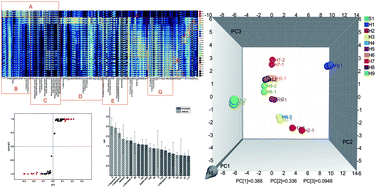Gas chromatographic-ion mobility spectrometry combined with a multivariate analysis model exploring the characteristic changes of odor components during the processing of black sesame†
Abstract
Black sesame (Sesamum indicum L.) is a Chinese dietary herb that has been widely used in the medical and healthcare fields in China. According to the theory of Traditional Chinese medicine processing, reasonable processing (steaming and drying many times) can increase the tonic effect and reduce the adverse factors generated during long-term use. At present, the processing degree of black sesame is mainly judged based on subjective experience. However, due to the lack of objective and quantitative control indicators, quality fluctuations easily occur. Therefore, for better application, its processing technology needs scientific monitoring methods. Herein a gas chromatography-ion mobility spectrometry (GC-IMS) technique was applied as a monitoring method to differentiate the processed products of black sesame in different processing stages. The response data of volatile components obtained from the samples were processed by the built-in data processing software in the instrument to identify the different components for further principal component analysis (PCA) and orthogonal partial least squares discriminant analysis (OPLS-DA). From fingerprint comparison, 70 differential signal peaks were screened, 32 of which were qualitatively identified, mainly monomers and dimers of 20 compounds. On this basis, the PCA model shows that there was a significant difference between the raw product (S1) and the processed products (H1–9); moreover, there was a certain correlation between the differential changes of samples in different processing stages (H1–9) and the processing times. The OPLS-DA model specifically shows the differential components in the processing with potential characteristics peaks of 41, 105, n-nonanal, 2 and ethanol can discriminate whether the BS has undergone the first processed. And the dynamic changes of the three characteristic peaks of 1-hexanol, acetic acid and 107 can determine the specific degree of processing of BS. The research proves that GC-IMS combined with a multivariate analysis model can provide scientific data for identifying the characteristic odor components of black sesame.



 Please wait while we load your content...
Please wait while we load your content...